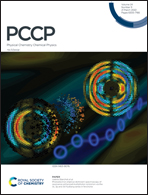Pressure tuned incommensurability and guest structure transition in compressed scandium from machine learning atomic simulation†
Abstract
Scandium (Sc) is the lightest non-main-group element and transforms to a host–guest (H–G) incommensurate structure under gigapascal (GPa) pressures. While the host structure is stable over a wide pressure range, the guest structure may exist in multiple forms, featuring different incommensurate ratios, and mixing up to generate long-range “disordered” guest structures. Here, we employed the recently developed global neural network (g-NN) potential and the stochastic surface walking (SSW) global optimization algorithm to explore the global potential energy surface of Sc under various pressures. We probe the global minima structure in a system made of hundreds of atoms and revealed that the solid-phase transition between Sc-I and H-G Sc-II phases is fully reconstructive in nature. Above 62.5 GPa, the pressure will further destabilize the face-centered tetragonal (fct, Sc-IIa) guest structure to a body-centered tetragonal phase (bct, Sc-IIb), while sustaining the host structure. The structural transition mechanism of this work will shed light on the nature of the complex H–G structural modifications in compressed metals.



 Please wait while we load your content...
Please wait while we load your content...